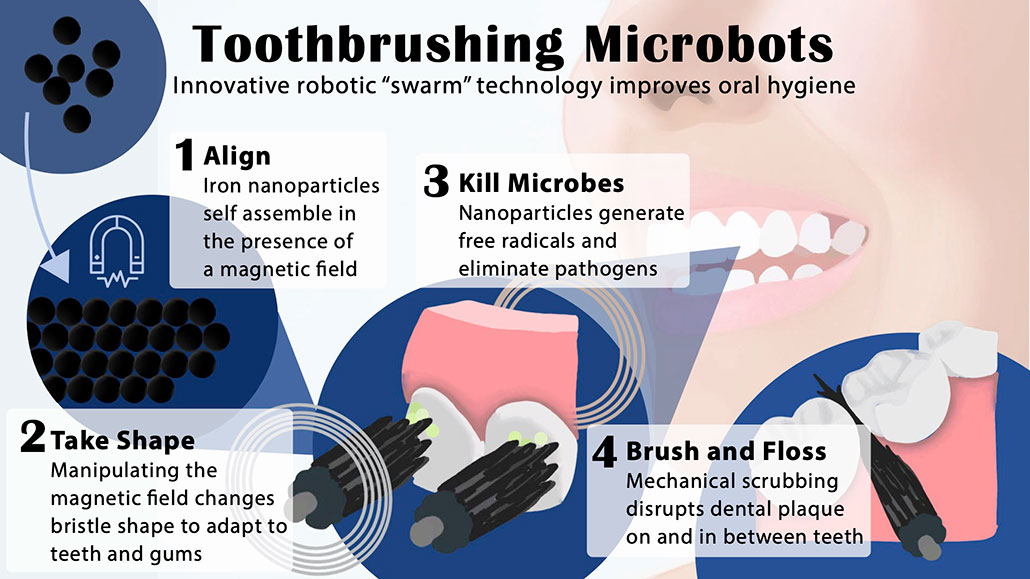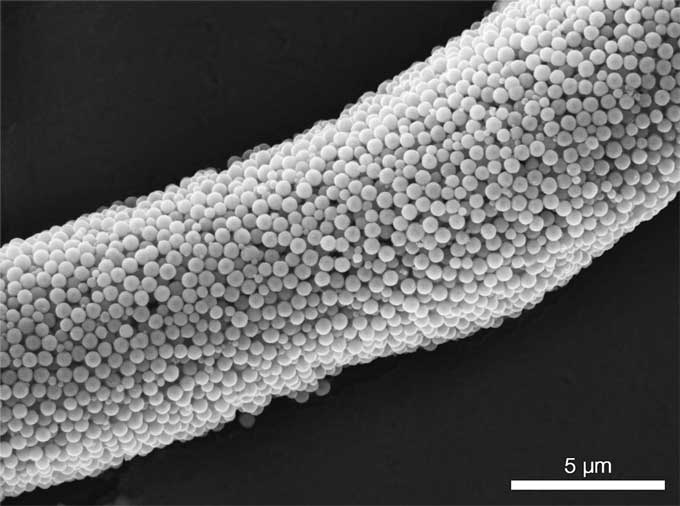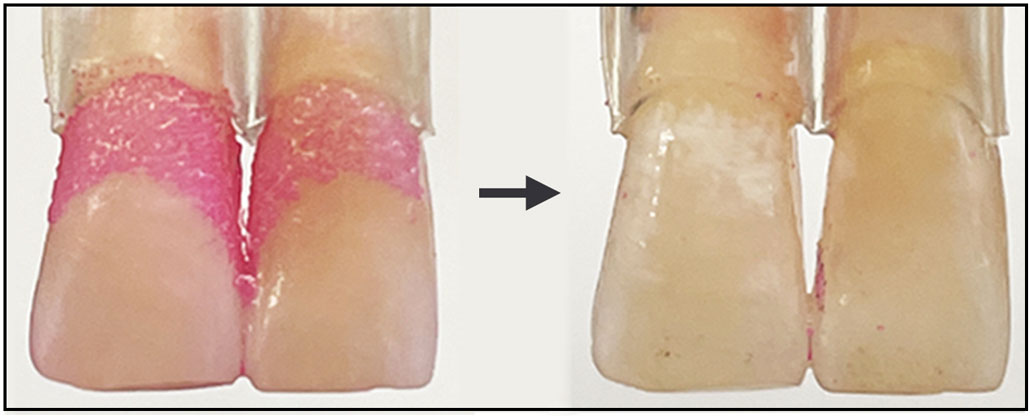A shape-shifting robotic tooth-cleaner might one day brush for you
It’s made of billions of magnetic nanoparticles that form bristles or floss

What if you didn’t have to use your hands to brush your teeth? Someday, a shape-shifting swarm of nanoparticles might automatically brush and floss for you. The nanoparticles even kill bacteria just like toothpaste or mouthwash.
Capuski/E+/Getty Images Plus
Share this:
- Share via email (Opens in new window) Email
- Click to share on Facebook (Opens in new window) Facebook
- Click to share on X (Opens in new window) X
- Click to share on Pinterest (Opens in new window) Pinterest
- Click to share on Reddit (Opens in new window) Reddit
- Share to Google Classroom (Opens in new window) Google Classroom
- Click to print (Opens in new window) Print
Someday, you may no longer need to brush and floss your teeth by hand. Instead, a swarm of billions of nanoparticles could automatically do all that work for you. The nanoparticles are very tiny, metallic balls. Magnets make them move. If you set up a magnet in just the right way, says Ed Steager, “You can arrange them into any shape you want.”
Why not a shape-shifting, tooth-cleaning robot?
Steager is an engineer at the University of Pennsylvania (Penn) in Philadelphia. His colleague Hyun (Michel) Koo is an inventor and dental researcher there. Together, they found a way to form the nanoparticles into long, skinny bristles, a lot like the ones on a toothbrush. But these bristles shape-shift to fit whatever surface they encounter. They can even squeeze between teeth, like floss.
A new way to clean teeth could help out anyone who finds this chore tedious, says Koo. But it would be especially life-changing for people with disabilities or illnesses that make it difficult or impossible to hold and move a toothbrush.
The scientists tested the robotic bristles in the lab. They removed gunk from plastic teeth and from human teeth that had been extracted. Koo, Steager and their colleagues reported their invention in ACS Nano on June 28.
The device isn’t yet ready for people to use. The magnets and nanoparticles will need to fit comfortably and safely inside a person’s mouth. The researchers are working with a company to accomplish this safely and effectively. But if these inventors can perfect the device, a lot of people will benefit.
Mary Anne Melo is a dental researcher at the University of Maryland in Baltimore. She says of the Penn robotic brush, “It’s extremely innovative.”
A dentist and an engineer walk into a coffee shop…
That may sound like the opening of a joke. Actually, it’s how the new teeth-cleaning system came to be. Koo and Steager focus on completely different areas of research. Steager builds tiny robots. Koo tries to find new ways to treat dental issues, such as plaque — a sticky build-up of food and bacteria that coats teeth. If not removed, plaque can lead to decay and painful holes in the teeth. Dentists call these dental caries. Most of the rest of us know them as cavities.
Even though the scientists’ research goals were very different, both were using the same nanoparticles. Steager was using them to form moving, robotic structures. Koo was using them to do the work of a mouthwash in killing bacteria.
Steager and Koo worked just a few buildings apart on the same campus. One day, a colleague who knew about both of their projects told them they should meet for coffee. At that meeting, they realized that Steager’s robotic structures might be able to take the shape of a toothbrush or floss. Though Steager had been working with these nanoparticles for a long time, it had never occurred to him before that they might be useful in this way. It was “an a-ha moment,” he recalls.

Magnet power
The tooth-cleaning robot works thanks to two magnets. One goes on each side of the teeth. The nanoparticles sit in a water-based solution between the magnets. All of this may fit into something the size and shape of a mouthguard, though the researchers haven’t settled on a design for the device yet.

Magnets form a magnetic field in the space around them. You can imagine this field as lines extending outward from each magnet. A refrigerator magnet makes a permanent magnetic field. But the magnets Steager and Koo used are electromagnets. They only make fields when electricity flows through them.
When the magnets are turned off, the nanoparticles float randomly in the solution. As soon as one magnet gets turned on, the nanoparticles clump together near its center. “They all like to gather in the same spot,” says Steager. When the researchers turn on the other magnet and turn off the first one, the nanoparticles extend outward in long, skinny bristles.
When there’s a tooth in the way, these bristles can’t stretch out as far as they want. So they push against the tooth’s surface. If there’s a gap between teeth, they push into the gap. Moving the magnets makes the bristles move against and between teeth. All that motion breaks up plaque.
Death to bacteria
As a bonus, the nanoparticles also kill bacteria living in plaque and the mouth. The water-based liquid that holds them contains peroxide. This is a substance commonly added to toothpaste and mouthwash. It kills some bacteria on its own. But when these nanoparticles react with it, powerful germ-killing molecules get created. They are 500 times better at fighting bacteria than plain peroxide, says Koo.

Koo had already tested this aspect of the nanoparticles in a 2021 study. There, human volunteers wore dentures containing pieces of real teeth. They let plaque build up on these bits of real teeth (so they didn’t have to skip brushing their own teeth and risk cavities). Then they used the nanoparticles like a mouthwash to remove bacteria. But this didn’t scrub off sticky plaque.
The new bristly shapes created by the magnets now take these hard-working particles to the next level.
The teeth are “a tricky area to clean,” notes Melo. Toothbrushes, floss and mouthwash don’t always get the teeth clean enough to avoid problems, she says.
The new invention is just a proof of concept. The researchers still need to turn it into a product that people will want to use. It must fit comfortably and safely in people’s mouths. It can’t draw too much power or cost too much. “There’s a lot of engineering to get from here to there,” says Steager. But, as Melo says, “every good idea needs to have a start.”
This is one in a series presenting news on technology and innovation, made possible with generous support from the Lemelson Foundation.







